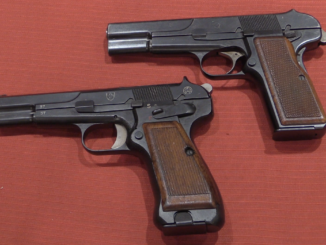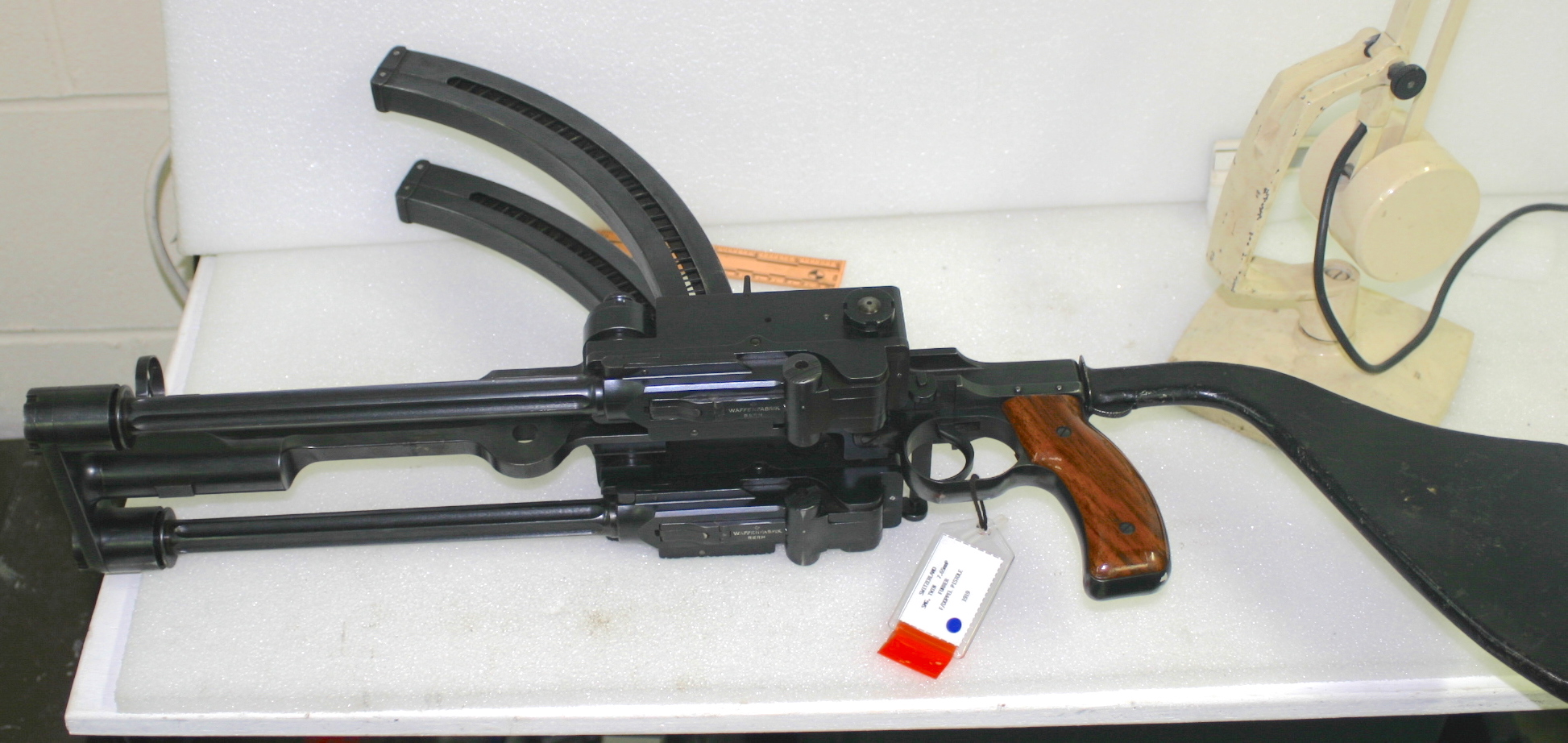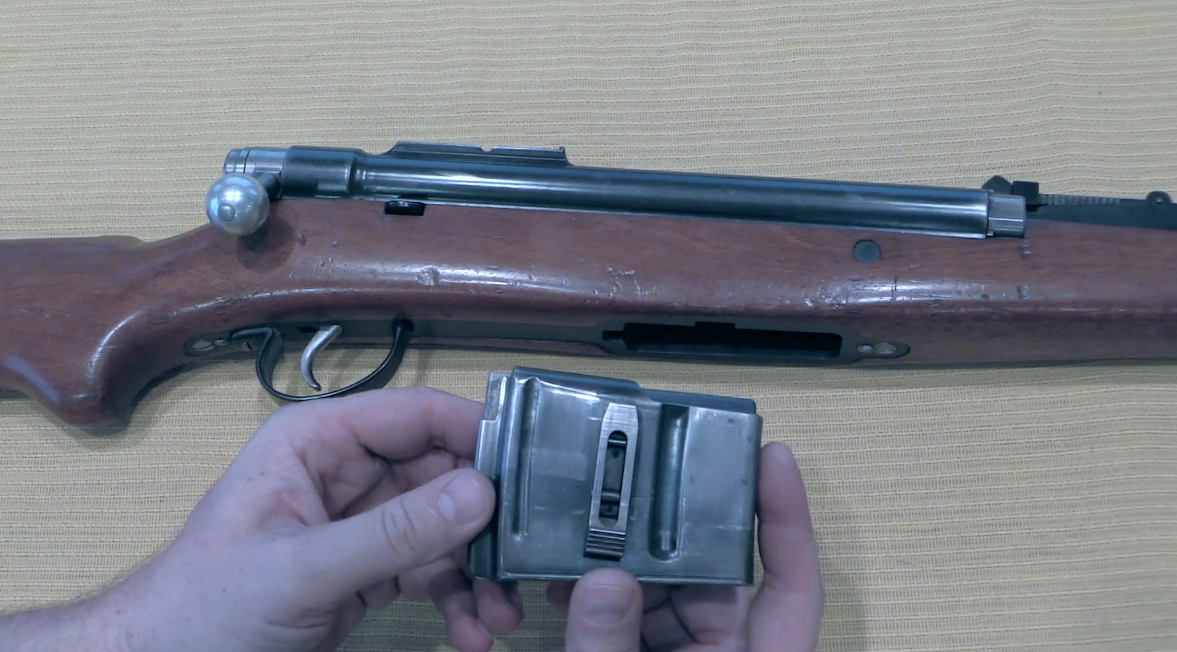In the 1870s, Switzerland was looking for a new military revolver, and they were particularly interested in finding a system which would allow faster reloading than the standard loading gate and manual ejection rod. A military veteran and gunsmith by the name of von Steiger in Thun submitted a design which automatically ejected an empty case each time the gun was fired. This did dramatically increase the rate of fire (one Swiss officer in the trials managed 10 rounds in 20 seconds), but at the price of complexity and durability.
The first series of von Steiger revolvers were in 9mm, followed a few years later by a redesign to the 10.4mm cartridge which would ultimately be adopted in 1878. We have six examples to look at today, form prototype #2 through one of the trials pistols in 10.4mm. Ultimately the Abadie system was chosen in favor of von Steiger’s guns. Abadie’s gun was not as fast as von Steiger’s to reload, but it was still faster than the traditional system and did not sacrifice as much cost or durability. It would prove to be quite successful, and was adopted by many European militaries in the late 1800s.
Thanks to Kessler Auktionen AG for letting me film some of their guns – if you are looking for interesting and unusual arms in Europe, make sure to check them out!




That inside makes my Luger look simple. Great video thanks Ian Got one small typo,”…today, form prototype…” I wonder if the folks at Charter Arms or S&W (in the past) were aware of this when they put that tab in the start to work (today) 9X19, .40 and .45ACP?
Keep your powder dry and your faith in God.
*star
What about the first shot and the very first ejection on a fully loaded cylinder ? Would it eject a live round ?
Yes, what prevents the 5th round to be ejected when firing the first one?
Where there meant to be carry with an empty chamber under the hammer?
I don’t see if the hammer is a rebounding one.
Regarding the safety on right side, this make sense if the revolver is to be used with the left hand, the right hand using the sword.
Perhaps the ejection system doesn’t eject on the first shot. I recall that another self-ejected revolver worked normally without ejecting if the loading gate was kept closed…
Perhaps it don’t work on the first shot, but I don’t saw any clue of this in the video.
If no mechanical feature prevents the 5th round to be ejected when firing the first one, is it possible that the inertia of the bullet does the job?
As commomly kkown, revolver bullets tend to slip forward on firing if they are not properly crimped.
I think if you watch those portions of the video again, some of the questions will be answered… The hammer falls on a cartridge—“bang!” The hammer goes back, and the cylinder begins to turn clockwise. The extractor/ejector begins to do its work. The hammer falls again–“bang!” and now the extractor/ejector flips the empty cartridge case at the 1 o’clock position (OK, more like 2 with a five shooter), and so on subsequently. The first shot does not produce an ejected cartridge nor an ejected case.
Your questions are interesting if the hammer is de-cocked however… Does that pluck a live cartridge out? Is it therefore a double action only design? Seems unlikely…
I suspect that there would be no “first round”, as it appears that this revolver, with a hammer-mounted firing pin typical of 19th century designs, does not have a rebounding hammer, also typical of the era.
This might be the reason for the manual safety on the early prototype. As with the Model 1879 and 1883 German Reichsrevolvers that came after it, the original drill may have been intended as “load five rounds, half-cock hammer, apply safety, holster.” With the lanyard ensuring that if you dropped it, it couldn’t hit the ground.
Incidentally, the controls being on the right strongly indicate that this was originally intended as a cavalry revolver. The drill back then was to use the pistol in the left hand to keep the right hand free for the saber or the reins.
This would also explain the contoured ejector trough to throw the case well to the right. Otherwise, fired left-handed, the empty would likely hit the shooter right in the face,as anyone who’s ever tried to fire an early AR-15 “southpaw” without the case deflector on the upper receiver has no doubt experienced.
The problem of course is that with five rounds in situ, if the ejector works correctly you lose one. Or, if the mass of the unfired round prevents clean ejection, you have a case sticking halfway out of the chamber as the cylinder rotates, until it hits the frame on your second trigger pull and jams the whole production.
In other words, this is a four-shot weapon, period. That is, if you want it to actually work.
This is the most likely reason it was rejected. The army wanted a double-action revolver with at least a five or six-shot capacity. The 10.4mm Waffenfabrik Bern Modell 1872 rimfire, and its successor the Modell 1872/78 centerfire, gave them exactly that. For a lot less trouble and expense than this one would have.
cheers
eon
Such a revolver, with fixed firing pin and no rebounding hammer, is not safe to carry with the hammer down on a live cartridge. It might, depending on both the gun’s design and the user’s choice, be carried with an empty chamber, with the hammer lowered into a notch between chambers, or with all chambers loaded at half-cock.
If carried with an empty chamber under the hammer, of course there is no difficulty — the ejector will cycle, but there’s nothing to eject.
If carried with the hammer down between chambers, it seems possible to time the safety notches so that the ejector already rests on top of the cartridge it would normally eject, and has no chance to get under it as you cock the hammer for the first shot. This would be my preferred solution, but it doesn’t appear to be implemented here — the 10.4mm version does have big sawtooth safety notches in the rear of the cylinder, but the timing doesn’t appear to work out.
Finally, if carried half-cocked, a similar process of staging the cylinder so the ejector is on top of a cartridge could work — but the safety would have to lock the cylinder in the appropriately-staged position, and I see no evidence either of the manual safeties on the 9mm versions do that.
As far as I can tell, the original 9mm versions seemed to be designed around empty-chamber carry, and thus first-round ejection was a non-issue. The 10.4 versions are clearly designed for between-cylinders carry, but don’t seem to have addressed first-round ejection in any way.
Of course, losing one round to empty-chamber carry is not so big an issue when you can continually thumb rounds into the cylinder to keep firing — but perhaps von Steiger and the Swiss military didn’t agree on that.
Robin: “Holy freakin’ monster steam-punk revolver, Batman!”
Batman: “You know …. Rob-in… I rather LIKE IT. It has a sort of… BATCAVE quality, or as the French have it … Je ne’sais QUOI.”
The 10.4mm is one ugly-if-fascinating revolver! While over-engineering is commonly held as a trait of the German-speaking world, the Swiss rather sensibly went for the Abadie, as did the Italians, and even the Portuguese.
The twee little screwdriver is adorable! I love it. I suppose the one question I have is whether it was loaded like an Abadie-type by pulling the trigger to rotate the cylinder somehow? Or after the cartridge is squeezed in past the catch/gate spring on the left, the cylinder is rotated by hand with the hammer on half cock?
Fascinating stuff on the Swiss guns, Ian!
BIG HINT: When do we get to see the AK-52/ 53 gas-operated 7.5x55mm rifle with the fixed bolt and reciprocating barrel…??!
After the latest news on TV and all these tears for the gun circulation, someone has to say few words about the circulation of lunatics based on several human rights,the modern life which bombs people with any kind of example and message on a screen 24/24, and all these people who don’t know yet that there is no real treatment for the flu, the madness, and…love! Otherwise, i vote for the elimination of the knives in the kitcen,and the forks on the table…A gun is a potential danger. The one who holds it and doesn’t go well in his mind is a sure danger,and more danger is the reason that he is still in circulation.Like in childrens’ criminality, the parents should be asked firstly what their kid was doing in the place of the crime.The kid secondly…
I am searching for a Johnson rifle receiver (rifle) that has been damaged. My intention is to convert it to the “Daisy Mae” version that Mr. Johnson created only ten of.Can you please recommend some possible sources?
Thank you.
Gerald Easson
147, central Street
Farmington, NH 03835
What a great idea. I hope you will succeed.
This is the best looking version of the Johnson.
“von Steiger in Thun submitted a design which automatically ejected an empty case each time the gun was”
This reminded me about Becker self-loading shotgun
https://silvercore.wordpress.com/2014/06/03/the-becker-semi-auto-revolving-shotgun-silvercore-firearms-training-bc/
“It would prove to be quite successful, and was adopted by many European militaries in the late 1800s”
Wait, now I confused, Abadie system was if I am not confused invented in 1860s-1870s, so how it could be adopted in say 1808 or 1809?
“Late 1800s” can mean either late in the first decade of the 19th Century or late 19th Century. Obviously Ian meant the latter.
“late 19th Century”
Now make sense, I did not take in account U.S. inclination for making things confusing.
No. Late 1800’s is last decades of 19th century only. Early decades of same century are early 1800’s. I teach English. I also have an M.A. in history
I remember reading a Sherlock Holmes story in which Conan Doyle seemed to be under the impression that a revolver might eject its own cartridges. Maybe this was what he had in mind?
I vaguely recall that there was 19th century British revolver with modification to eject cartridge with similar fashion, but I don’t remember designation…
The Silver & Fletcher patented modification for the Webley revolvers issued to the Royal Irish Constabulary is exactly what you’ve described. Its extraction mechanism, which was a hooked hammer, works only when the loading gate is open. I’m pretty sure the ejected casings would fly a bit too close to the user’s face.
“Silver & Fletcher patented modification for the Webley revolvers”
Yes this is that one
I like that loading gate – it kinda looks like you could stick a tube magazine behind it…
Anybody out there familiar with “The Difference Engine” by Sterling & Gibson, an early steampunk novel, maybe the first? In it, one of the protagonists encounters an Argentine GAS OPERATED self-cocking revolver. Don’t remember if it had a safety-catch.
So we need an sf writer to create the great 19th-century all-feature revolver, the Abadie-Fosbery-Von Steiger-Webley (alphabetical credits) easy-loading self-cocking self-ejecting solid-frame black powder revolver. (Skip two features if you revert to top-break).
The Ballester-Molina revolver described had a very simple system. A single-action, it had a gas takeoff near the muzzle to a spring-loaded piston that ran through the hollow cylinder base pin. When fired, the piston rod was thrust backward against the hammer neck and threw it back to full cock, and a coil spring between the wider front part of the rod and the front of the frame pushed to rod back to the front, ready to repeat the performance.
This is similar to one of the patents of Regulus Pilon, an American who patented a self-ejecting, self-cocking system for a rifle in 1869 (!). That may be where the authors got the idea from.
Then again, maybe such a revolver system was really proposed by somebody back then. The majority of “automatic revolvers” like the Webley-Fosbery, Union, or Zulaica were recoil-operated. Even the modern-day Mateba Autorevolver uses a recoil-opertion system. But there’s really no “law” that says a gas-operated system wouldn’t work.
cheers
eon
“But there’s really no “law” that says a gas-operated system wouldn’t work.”
In fact, it should be possible to make single-action revolver into gas by adding gas piston atop hitting hammer (this might require some alteration to hammer shape)
Quick search in U.S. patents reveal that various gas-operated revolvers were patented. Examples:
US2560292A Gas piston operated revolver (1948)
US2980096A Gas powered revolver (1959)
US3045556A Gas operated automatic revolver (1959)
US3212489A Gas-powered revolver (1963)
US3547095A Gas-operated revolver (1968)
US4197784 SEMI-AUTOMATIC REVOLVER (1980)
see here: http://www.freepatentsonline.com/4197784.pdf
it deploy that idea which I described: gas-piston over-barrel acting against hammer, so in fact such thing as gas operated revolver is (hope that is proper word) patentable, but up to today seems to be not marketable. Probable answer is that classic [double-action] revolver allow usage of cartridge with any powder charge, as long as it is not too big (so .357 Maximum revolver will fire effortlessly .38 Special cartridge) in case of gas-operated revolver it is not so
” easy-loading self-cocking self-ejecting solid-frame”
What about Landstad revolver: https://www.forgottenweapons.com/landstad-1900-automatic-revolver/ ?
I’m guessing that you would not pull the trigger to rotate the cylinder when loading? I then expand on that guess by assuming that the ejector is directly linked to the trigger, rather than the motion of the cylinder?
What a show; absolutely gorgeous guns and mechanics!
It also shows to us fans of FW how Ian progressed into worldwide circles of gun cognoscenti. Excellent news for all of us.
In one of J David Trubys books on silencers he shows a full auto ruger single action revolver in 30 m1 carabine supposedly used by a mafia hitman. It works like the Balester-Molina mentioned above except it had a m1 carabine short stroke gas piston threaded on to the muzzle to actuate the cylinder pin which cocked the revolver
On TFB last year somebody had a revolver which fed through a tube on the left into the cylinder and ejected to the right but I think it was a gas ejection system
Dean Grennell once related the tale of a full-auto Colt Single Action Army. It had a worn firing pin bushing, which fell out on the first round of a five shot string at the range. The unsupported primer blew out, throwing the hammer almost back to full cock, and it apparently broke the safety notch in the process. it repeated this performance until the last round was expended.
Grennell and the (shaken) owner later calculated that all five rounds discharged in roughly three-fourths of one second worked out to a cyclic rate of roughly 400 r/m, or approximately that of an M3 “grease gun”. But a Peacemaker weighs a good deal less than an M3. I’m not surprised that the shooter was a bit unnerved by the experience.
cheers
eon
i can’t figure out why this wasn’t adopted by other manufacturers. thats a pretty damn slick feature and one of the pain points of a revolver.
Were these sold by Kessler Auktionen AG? What did they fetch?